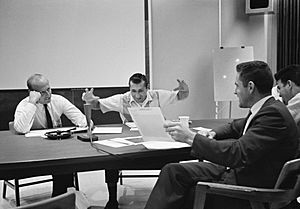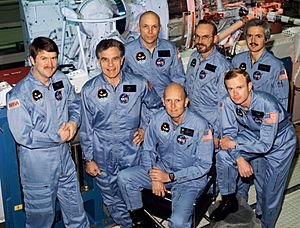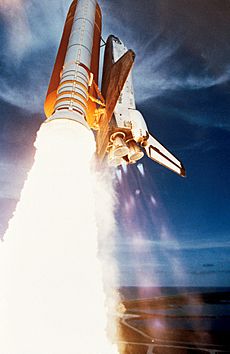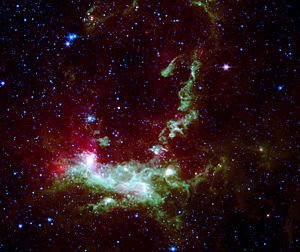Karl Gordon Henize facts for kids
{{Infobox astronaut | name =Karl G. Henize | other_names =Karl Gordon Henize | image =Henize.jpg | caption = | type =NASA Astronaut | nationality =American | birth_date =October 17, 1926 | birth_place =Cincinnati, Ohio, U.S. | death_date =October 5, 1993 (aged 66) | death_place =Mount Everest, Nepal | alma_mater =Virginia, B.A. 1947, M.A. 1948
Michigan, Ph.D. 1954 | occupation =Astronomer, space scientist | rank =![]() Lieutenant commander, USNR | selection =1967 NASA Group 6 | time =7d 22h 45min | mission =STS-51-F | insignia =
Lieutenant commander, USNR | selection =1967 NASA Group 6 | time =7d 22h 45min | mission =STS-51-F | insignia =![]() | Date of ret = April 1986
| Date of ret = April 1986
| module = |} Karl Gordon Henize(October 17, 1926 – October 5, 1993) was an American astronomer, space scientist, and NASAastronaut. He was also a professor at Northwestern University. Karl Henize worked at many observatories around the world. He was part of the support team for Apollo 15and the Skylabmissions. As a mission specialist on the Spacelab-2 mission, he flew on the Space ShuttleChallengerin 1985. He received the NASA Exceptional Scientific Achievement Medal in 1974. Karl Henize passed away in 1993 during a trip to Mount Everest. He was testing equipment for NASA at the time.
Contents
- Growing Up and Learning
- What Did Karl Henize Do?
- Karl Henize as a NASA Astronaut
- His Final Expedition
- Groups and Awards
- His Writings
- See also
Growing Up and Learning
Karl Henize was born in Cincinnati, Ohio, on October 17, 1926. He grew up on a small dairy farm. From a young age, Karl was fascinated by space. Since space travel wasn't common yet, he became very interested in astronomy.
He built his own telescopes and read every book about astronomy he could find. Karl was a Boy Scout and earned his only merit badge in astronomy. His hobbies included computers, stamp collecting, mathematics, and astronomy. He also enjoyed racquetball, baseball, diving, and mountain climbing.
Karl went to elementary and high school in Mariemont, Ohio. He played baseball and was on the tumbling team. He joined the V-12 Navy College Training Program during World War II. He studied at Denison University and the University of Virginia.
Even though the war ended before he became a Naval officer, he joined the U.S. Naval Reserve. He became a lieutenant commander. At the University of Virginia, he earned a bachelor's degree in mathematics in 1947. He then earned a master's degree in astronomy in 1948. He also did research at McCormick Observatory. In 1954, he received his Ph.D. in astronomy from the University of Michigan.
Karl Henize married Caroline Weber. They had four children: Kurt, Marcia, Skye, and Vance.
What Did Karl Henize Do?
From 1948 to 1951, Karl Henize worked as an observer for the University of Michigan Observatory. He was stationed at the Lamont–Hussey Observatory in Bloemfontein, South Africa. There, he used a special telescope to survey the southern sky. He looked for stars and nebulae that showed signs of hydrogen light.
In 1954, he became a researcher at the Mount Wilson Observatory in California. He studied stars and nebulae using light and spectrum analysis. From 1956 to 1959, he was a senior astronomer at the Smithsonian Astrophysical Observatory. He was in charge of setting up and running a worldwide network of 12 stations. These stations used cameras to track artificial Earth satellites.
In 1959, Karl Henize became a professor in the Astronomy Department at Northwestern University. He taught and researched planetary nebulae, special types of stars, and star groups. He also spent time as a guest observer at Mount Stromlo Observatory in Australia.
Henize discussing the Ultraviolet Astronomical Camera Experiment with the Gemini 11 astronauts.
Karl Henize also studied ultraviolet optical systems and space astronomy. He led an experiment called S-013. This experiment used special cameras to capture ultraviolet light from stars during the Gemini 10, 11, and 12 space flights. He also led experiment S-019 on Skylab. This used a special telescope to get ultraviolet light from faint stars.
From 1974 to 1978, Henize led a NASA team for STARLAB. This was a plan for a 1-meter ultraviolet telescope for Spacelab. He also chaired a NASA group for the Spacelab Wide-Angle Telescope. He wrote or helped write 70 scientific publications about his astronomy research.
Karl Henize as a NASA Astronaut
The crew assigned to the STS-51F mission.
Karl Henize first applied to be a scientist-astronaut but was too old at 37. In 1967, NASA removed the age limit, and he was chosen as a scientist-astronaut. Astronauts who couldn't fly jets had to complete a 53-week training program.
He was part of the support team for the Apollo 15 mission. This team helped the main astronauts with the science parts of the mission. He also supported the Skylab 2, 3, and 4 missions. He was a mission specialist for a Spacelab practice mission in 1977. He flew jets for 2,300 hours.
Liftoff on July 29, 1985, sending Dr. Henize into Earth orbit
Karl Henize was a mission specialist on the Spacelab-2 mission (STS-51-F). This mission launched from Kennedy Space Center, Florida, on July 29, 1985. He flew with Commander Gordon Fullerton, Pilot Roy Bridges, fellow mission specialists Anthony England and Story Musgrave, and two payload specialists, Loren Acton and John-David Bartoe.
This mission was special because it was the first time they used only a "pallet" (a platform for experiments) from Spacelab. It was also the first time they used the Instrument Pointing System (IPS). The mission carried 13 main experiments. Seven were about astronomy and the sun. Three studied Earth's ionosphere (a part of Earth's upper atmosphere). Two were about life science, and one studied superfluid helium.
Karl Henize's jobs included testing the IPS, operating the Remote Manipulator System (a robotic arm), keeping the Spacelab systems working, and running several experiments. After orbiting Earth 126 times, the Challenger landed on August 6, 1985. With this flight, Karl Henize spent 190 hours in space.
In 1986, he retired as an astronaut. He then became a senior scientist in the Space Sciences Branch. He studied space debris and dangers to the space station.
His Final Expedition
Karl Henize was on leave from NASA when he joined a hiking trip to Mount Everest. He wanted to test a special device called the Tissue Equivalent Proportional Counter (TEPC). This device would show how people's bodies react to radiation at different heights. This information was important for planning long space missions.
Karl Henize first got used to the high altitude in Kathmandu, Nepal. Then he went to the expedition base camp in China. On October 4, 1993, he began the hike with three other people. At 22,000 feet, he reported having trouble breathing. Oxygen treatments didn't help, so they returned to base camp.
On October 5, Karl Henize passed away in his sleep. The cause was high altitude pulmonary edema (HAPE). This is a serious condition where fluid builds up in the lungs at high altitudes. Karl Henize was 66 years old. He was buried near the Changtse Glacier. He was survived by his wife, Caroline, and their four children.
Groups and Awards
Karl Henize was a member of several important groups, including the American Astronomical Society and the Royal Astronomical Society. He also belonged to the International Astronomical Union and Phi Beta Kappa.
He received the Robert Gordon Memorial Award in 1968. He also earned several NASA Group Achievement Awards. In 1974, he was given the NASA Exceptional Scientific Achievement Medal.
His Writings
Henize 206, a nebula cataloged by Henize.
In 1956, Karl Henize published a very important paper. It was called Catalogues of Hα-Emission Stars and Nebulae in the Magellanic Clouds. This paper listed many objects that are now named after him. Examples include the Superbubble Henize 70 and the planetary nebula Henize 3–401. He discovered over 2,000 stars! In total, he published 75 scientific papers.
See also
- List of people who died climbing Mount Everest
| Scientific career | |
| Fields | Astronomy |
|---|---|
| Thesis | The Michigan-Mount Wilson survey of the southern sky for Hα-emission stars and nebulae (1954) |





